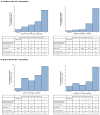Genital HIV-1 RNA predicts risk of heterosexual HIV-1 transmission
- PMID: 21471433
- PMCID: PMC3087186
- DOI: 10.1126/scitranslmed.3001888
Genital HIV-1 RNA predicts risk of heterosexual HIV-1 transmission
Abstract
High plasma HIV-1 RNA concentrations are associated with an increased risk of HIV-1 transmission. Although plasma and genital HIV-1 RNA concentrations are correlated, no study has evaluated the relationship between genital HIV-1 RNA and the risk of heterosexual HIV-1 transmission. In a prospective study of 2521 African HIV-1 serodiscordant couples, we assessed genital HIV-1 RNA quantity and HIV-1 transmission risk. HIV-1 transmission linkage was established within the partnership by viral sequence analysis. We tested endocervical samples from 1805 women, including 46 who transmitted HIV-1 to their partner, and semen samples from 716 men, including 32 who transmitted HIV-1 to their partner. There was a correlation between genital and plasma HIV-1 RNA concentrations: For endocervical swabs, Spearman's rank correlation coefficient ρ was 0.56, and for semen, ρ was 0.55. Each 1.0 log(10) increase in genital HIV-1 RNA was associated with a 2.20-fold (for endocervical swabs: 95% confidence interval, 1.60 to 3.04) and a 1.79-fold (for semen: 95% confidence interval, 1.30 to 2.47) increased risk of HIV-1 transmission. Genital HIV-1 RNA independently predicted HIV-1 transmission risk after adjusting for plasma HIV-1 quantity (hazard ratio, 1.67 for endocervical swabs and 1.68 for semen). Seven female-to-male and four male-to-female HIV-1 transmissions (incidence <1% per year) occurred from persons with undetectable genital HIV-1 RNA, but in all 11 cases, plasma HIV-1 RNA was detected. Thus, higher genital HIV-1 RNA concentrations are associated with greater risk of heterosexual HIV-1 transmission, and this effect was independent of plasma HIV-1 concentrations. These data suggest that HIV-1 RNA in genital secretions could be used as a marker of HIV-1 sexual transmission risk.
Conflict of interest statement
Figures

References
-
- Baeten JM, Overbaugh J. Measuring the infectiousness of persons with HIV-1: opportunities for preventing sexual HIV-1 transmission. Curr HIV Res. 2003;1:69–86. - PubMed
-
- Coombs RW, Reichelderfer PS, Landay AL. Recent observations on HIV type-1 infection in the genital tract of men and women. AIDS. 2003;17:455–480. - PubMed
-
- Anderson BL, Cu-Uvin S. Determinants of HIV shedding in the lower genital tract of women. Curr Infect Dis Rep. 2008;10:505–511. - PubMed
-
- Quinn TC, Wawer MJ, Sewankambo N, Serwadda D, Li C, Wabwire-Mangen F, Meehan MO, Lutalo T, Gray RH. Viral load and heterosexual transmission of human immunodeficiency virus type 1 Rakai Project Study Group. N Engl J Med. 2000;342:921–929. - PubMed
-
- Chuachoowong R, Shaffer N, Siriwasin W, Chaisilwattana P, Young NL, Mock PA, Chearskul S, Waranawat N, Chaowanachan T, Karon J, Simonds RJ, Mastro TD. Short-course antenatal zidovudine reduces both cervicovaginal human immunodeficiency virus type 1 RNA levels and risk of perinatal transmission Bangkok Collaborative Perinatal HIV Transmission Study Group. J Infect Dis. 2000;181:99–106. - PubMed
Publication types
MeSH terms
Substances
Grants and funding
LinkOut - more resources
Full Text Sources
Medical

